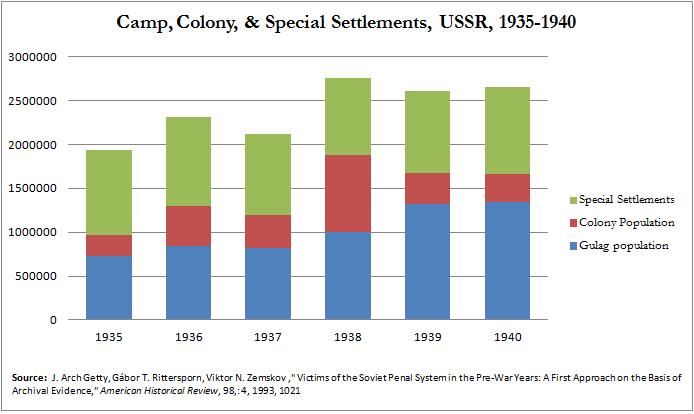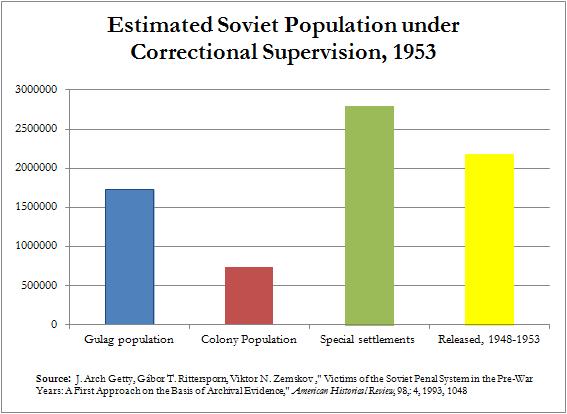Is this hyperbole? Here are the facts. The U.S. has 760 prisoners per 100,000 citizens. That’s not just many more than in most other developed countries but seven to 10 times as many. Japan has 63 per 100,000, Germany has 90, France has 96, South Korea has 97, and Britain–with a rate among the highest–has 153. Even developing countries that are well known for their crime problems have a third of U.S. numbers. Mexico has 208 prisoners per 100,000 citizens, and Brazil has 242. As Robertson pointed out on his TV show, The 700 Club, “We here in America make up 5% of the world’s population but we make up 25% of the [world's] jailed prisoners.”
It is no hyperbole to say that the US prison industrial complex is unacceptable, especially for a country that purports itself the world’s preeminent democracy. But it is hyperbole because placing the US next to Stalinism (and Nazism for that matter) is inherently hyperbolic. The rhetorical move is supposed to provoke an emotional reaction not stimulate critical awareness. And as much as American liberals would like to think that the numbers of bodies ensnared in the US prison industrial complex is as bad, if not worse, than Stalinist Russia, the situation is far more complicated.
Here I don’t mean the quality of the Stalinist system No one is claiming that the US system is worse than Stalin’s forced labor camps. I only mean the quantity of humans in both systems.
The Stalinist penal system was a complex network of punishments and detentions: prisons, noncustodial forced labor, corrective labor camps, forced labor detention (katorga) special settlements, and corrective labor colonies. I won’t go into the meanings and various differences between these. Though experts make clear distinctions between these various units, to the popular mind, they all fall under the general name of gulag. The numbers of people, which also included children, in this penal machine at any given period remains partial. Up 20 percent of the gulag population was released every year, new inmates went in, corpses went out, some even managed to escape. But exactly how many people under Stalin’s correctional supervision is unknown.
Here’s the population of some of these institutions between 1935 and 1940:
According to the straight numbers, the Stalinist system did not exceed the US’ six million during the years of the Great Terror. In 1938, there were 2.7 million people in the “gulag.” But this doesn’t include everyone under Stalinist “correctional supervision.” Therefore it doesn’t take account of prisons and released gulag prisoners who were forced to carry “Form A” which detailed their past crime, prison term, the deprivation of civil rights up to five years, and restricted where they could settle. There were roughly 2 million people released from the gulag between 1934 and 1940 which etches the Stalinist number closer to the United States.
Things change in 1953, the height of the Stalinist gulag. Here are the numbers:
This means an estimated 7.4 million people were under Stalinist correctional supervision 1953, exceeding Zakaria’s and Gopnik’s 6 million for the United States. Again the numbers are probably higher since these numbers don’t include everyone in the Stalinist penal system.
Things get even more complicated when you consider the gulag population per 100,000 citizens. According to Eugenia Belova and Paul Gregory, the Soviet institutionalized population in 1953 was 2,621,000 or 1,558 per 100.000. When you include special settlements, the numbers jump to 4,301,000 or 2,605 per 100,000. This puts the 760 per 100,000 in the United States into perspective.
The numbers in the United States should produce outcry. No argument there. But caution is required when Stalinist Russia is thrown into the mix, that is, if you want to go beyond rhetoric and emotion.
Other Sources:
Eugenia Belova and Paul Gregory, “Political Economic of Crime and Punishment Under Stalin,” Public Choice, 140, 2009.
Steven A. Barnes, Death and Redemption: The Gulag and the Shaping of Soviet Society, Princeton, 2011.
Steven A. Barnes, Death and Redemption: The Gulag and the Shaping of Soviet Society, Princeton, 2011.


No comments:
Post a Comment
Note: Only a member of this blog may post a comment.